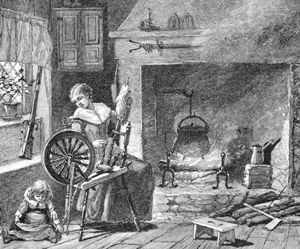
In another of a continuing series of sagas of our foremothers, today we discuss Grace Robbins.
Grace, daughter of Arthur Neale and Grace O’Hara, was probably born in Brackley, Northamptonshire. But her true home seems to have been Dunluce Castle in Ireland, where her mother supposedly was born. She was a cousin of Admiral James Neale, who would be a favorite of King Charles I.
At the age of 15, Grace was taken to Virginia aboard the Diana, with Sir George Yeardley. They arrived in 1618. Within a few years, Grace had met and married Lt. Edward Waters, her elder by 14 years. They moved to Elizabeth City where Waters had patented several hundred acres of land. During the disastrous Good Friday 1622 Indian attack, both Grace and Lt Waters were captured by the Indians. While the Indians were celebrating, Edward, a military man, found one of their canoes. Luckily, the couple was not tied up or well guarded. The two stole the canoe and made their way to Jamestown.
Apparently, the couple spent some time in Blount Point, in what is now Newport, Va., before going back to their land in Elizabeth City. Their son, William, born 1623 is recorded as being born there. However, by the census, or muster, of 1625, they were home. A child was born to them that year, Margaret.
Several years later, Lt. Waters visited England, where he died in August 1630, leaving Grace with two small children. After several years, Grace met the widower Obedience Robbins and his . They married. William, older, now, probably went to England for university studies.
Obedience Robbins, a trained surgeon and planter, had been in Virginia since 1628. When they married, they moved to his land on the Eastern Shore, some of which he was granted for bringing people over, including himself, Grace and Margaret. During the next ten years, Obedience and Grace had five more children. Dorothea, John, Obedience III, Mary and Frances (who probably died young).
While Grace handled the plantation management, Obedience, who apparently did not serve in a medical capacity, was politically active. He had already served as burgess in 1629/30 and in quarter courts in the early 30s. Grace was used to this, since Lt. Waters had been in a similar position.
Although Robbins still held offices while getting married in England, he apparently seemed to need time off with the rapid coming of children. He was not as active in politics in the late 1630s, except as a member of the church council, or vestry. However, he did host the “laughing king”, the Indian chief, who came to visit every year in the spring. His and Grace’s hospitality was questioned on various occasions, even bringing the question into the courts, but hailed on others.
Grace had to have had great patience, since Obedience and their neighbor, Edward Scarborough, had great enmity for one another throughout their lives. They argued about boundaries of their own and boundaries of the counties. They argued about the treatment of the Indians, with Obedience being welcoming and Scarborough killing them. It only ended with the death of the men, just a few years apart.
Throughout the 25 or so years of their marriage, Robbins held land which he rented out, grew tobacco, which he sold and had means of transportation, mostly boats, which he rented. They lived on Cherrystone Creek, not far from the Chesapeake, where trade flourished. The family did well.
The Robbins did well for their children, too. Obedience’s daughter, Margaret, married Grace’s son, Col. William Waters. Their other children married into the most prominent families, like the Scarboroughs.
When Obedience died in 1662, Grace inherited a large, well-functioning plantation. Her remaining children and grandchildren inherited it when she died twenty years later.

Wonderful…My ancestress
I’m glad you found some info about a relative!